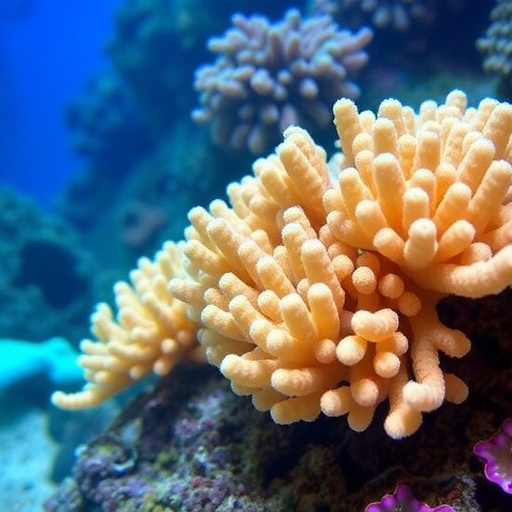The Great Barrier Reef, one of the most iconic ecosystems on the planet, is facing unprecedented challenges due to climate change. With rising sea temperatures, mass bleaching events have become a stark reality for marine scientists and conservationists. Amidst these alarming trends, a groundbreaking study conducted by Strudwick, Suggett, and Edmondson et al. has investigated innovative strategies to protect coral nurseries from the devastating effects of these bleaching events. This research, documented in Coral Reefs, aims to explore the benefits of protective shading and lowering methodologies that could be vital for preserving coral biodiversity.
The Great Barrier Reef, stretching over 2,300 kilometers off the coast of Australia, is not only a UNESCO World Heritage site but also a critical habitat for an array of marine life. Recent studies indicate that the coral cover in this ecosystem has been drastically reduced due to elevated water temperatures leading to widespread bleaching. Corals, once vibrant ecosystems teeming with life, lose their color and vitality under thermal stress, often leading to mortality. This alarming trend has prompted researchers to seek proactive measures to safeguard these marine treasures.
One of the most promising approaches outlined in the research is the implementation of protective shading techniques. These involve using materials that can attenuate sunlight and reduce heat stress on corals, thus directly addressing one of the key triggers of bleaching. By mimicking the natural canopy provided by larger marine organisms, these shading techniques can create microhabitats that are cooler and more conducive to coral health. This innovative approach not only serves to shield corals from harmful light but also fosters a more stable environment during extreme temperature durations.
Additionally, the researchers examined the methodology of lowering coral nurseries to deeper waters as a strategy for mitigating heat stress. By relocating these nurseries slightly deeper into the ocean, where temperatures are typically cooler and tides can be promoted more effectively, scientists are seeking a pathway to enhance coral resilience. Lowering these nurseries can help them escape some of the thermal pressures present at the surface while simultaneously improving water circulation around the coral structures.
As the data from the study reveals, the implications of protective shading and lowering for coral nurseries could be significant. The researchers conducted rigorous experimentation to assess the physiological responses of various coral species under different shading and depth conditions. This thorough analysis enabled them to draw meaningful conclusions regarding the resilience of different corals and the optimal strategies for their long-term survival amidst climate stresses.
Significantly, the study carefully measured the health parameters of the corals before and after exposure to protection strategies. Metrics such as photosynthetic efficiency, growth rates, and overall health were taken into account. Such detailed examination helps elucidate the potential of both protective shading and lowering methods, providing vital insights into the adaptability of coral nurseries under fluctuating environmental conditions.
The findings have provoked an essential dialogue regarding the role that artificial interventions can play in conservation efforts. From government agencies to environmental NGOs, the implications of this research resonate across all facets of coral reef management. The strategies employed in this research not only hold potential for immediate application but also lay a roadmap for ongoing research in the field of marine conservation.
Moreover, engaging with local communities and stakeholders is paramount for the success of these interventions. Educating and involving indigenous populations can foster a deeper connection to coral conservation, enhancing compliance with protective measures. By working collaboratively, scientists and local inhabitants can ensure that the efforts to protect the Great Barrier Reef are relevant and culturally appropriate.
As the world watches the plight of coral reefs unfold, studies such as this one serve as beacons of hope for marine biodiversity. They showcase the power of applied research to develop adaptable and practical solutions. Protecting these embryonic ecosystems contributes to maintaining not only biodiversity but also the myriad benefits that coral reefs provide, such as coastal protection, tourism opportunities, and economic value to surrounding communities.
The urgency of preserving the Great Barrier Reef cannot be overstated. With the rate of climate change progressing at an unprecedented pace, landscapes once teeming with life are now on the brink of collapse. Innovative research that offers actionable solutions, such as protective shading and lowering of nurseries, is more critical now than ever.
The study also highlights the necessity for broader-scale efforts to combat climate change. While local interventions may provide immediate refuge for coral species, global actions towards reducing greenhouse gas emissions will prove essential in the long run. Sustainable practices, both on land and sea, are key to addressing the root causes of environmental degradation affecting coral reefs and other vital ecosystems.
In conclusion, the research undertaken by Strudwick, Suggett, and Edmondson et al. shines a light on the potential pathways to protect one of the world’s most remarkable natural wonders. As stakeholders move forward towards implementing these strategies, the hope remains that such measures will enable the Great Barrier Reef to weather the challenges posed by climate change while fostering resilience among its delicate corals. This ongoing dialogue between science, conservation, and community engagement remains essential as we collectively strive towards a sustainable future for our oceans.
Subject of Research: Protective shading and lowering of coral nurseries during mass bleaching.
Article Title: Assessing protective shading and lowering of coral nurseries during a mass bleaching event on the great barrier reef.
Article References: Strudwick, P., Suggett, D.J., Edmondson, J. et al. Assessing protective shading and lowering of coral nurseries during a mass bleaching event on the great barrier reef. Coral Reefs 44, 1093–1105 (2025). https://doi.org/10.1007/s00338-025-02665-2
Image Credits: AI Generated
DOI: https://doi.org/10.1007/s00338-025-02665-2
Keywords: Coral reefs, bleaching, climate change, marine conservation, coral nurseries, protective shading, resilience.




